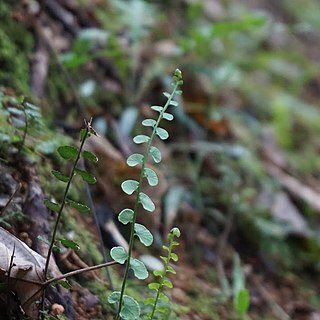Rhizome short-creeping, 1-1.5 mm ø; scales reddish brown, very narrowly triangular, to c. 2 mm long, to 4-seriate at base, a considerable apical portion uniseriate. Leaves close; petioles stramineous with dark base or dark to blackish brown throughout, abaxially at least in the upper part sharply bi-angular and if dark pale-margined. Lamina simply pinnate or bipinnate, herbaceous or chartaceous; pinnules dimidiate, very variable in shape, erose, free-veined. Upper pinnae of bipinnate leaves gradually to rather abruptly shortened, ± gradually passing into the non-conform terminal pinna. Terminal pinnules (segments) ± rhombic. Sori continuous or interrupted; indusium minutely to strongly and irregularly erose, ½ mm wide, usually falling short of the margin by half its width, rarely more strongly intramarginal or almost reaching the margin. Spores yellow to light brown, trilete, almost smooth, c. 25-30 μ.
Rhizome short-creeping, 1–1.5 mm diam.; scales narrow, reddish brown. Fronds ±monomorphic. Stipes clustered, mostly dark, shorter than the lamina. Lamina 1–2-pinnate, 7–30 cm long, herbaceous to chartaceous; apex long, 1-pinnate. Upper pinnules much-shortened; larger pinnules asymmetrically flabellate; smaller pinnules cuneate-subdimidiate, with an erose margin. Veins free, forked. Sori mostly continuous; indusium 0.3–0.5 mm wide, erose. Spores trilete.

